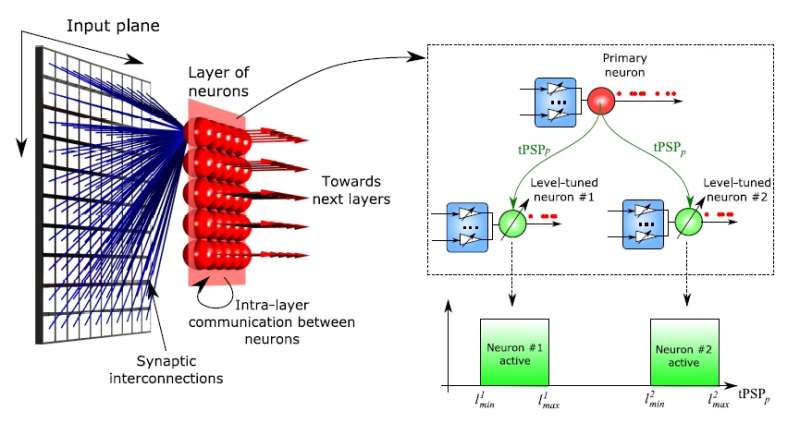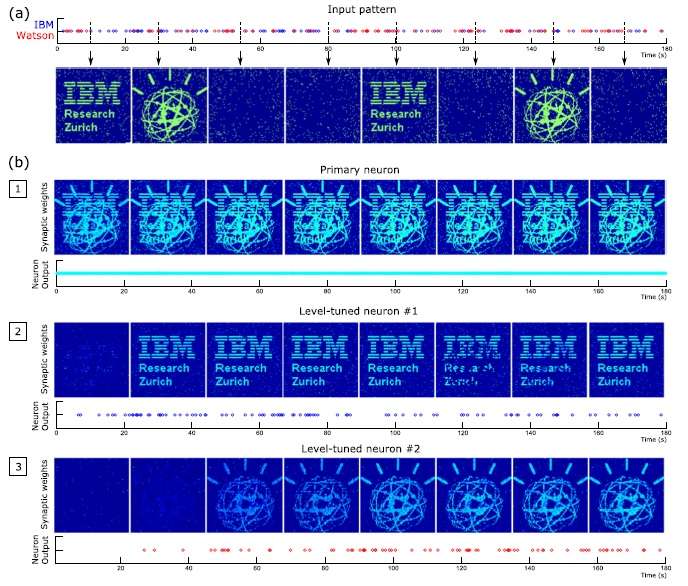August 18, 2016 feature
Neuromorphic computing mimics important brain feature

(Phys.org)—When you hear a sound, only some of the neurons in the auditory cortex of your brain are activated. This is because every auditory neuron is tuned to a certain range of sound, so that each neuron is more sensitive to particular types and levels of sound than others. In a new study, researchers have designed a neuromorphic ("brain-inspired") computing system that mimics this neural selectivity by using artificial level-tuned neurons that preferentially respond to specific types of stimuli.
In the future, level-tuned neurons may help enable neuromorphic computing systems to perform tasks that traditional computers cannot, such as learning from their environment, pattern recognition, and knowledge extraction from big data sources.
The researchers, Angeliki Pantazi et al., at IBM Research-Zurich and École Polytechnique Fédérale de Lausanne, both in Switzerland, have published a paper on the new neuromorphic architecture in a recent issue of Nanotechnology.
Like all neuromorphic computing architectures, the proposed system is based on neurons and their synapses, which are the junctions where neurons send signals to each other. In this study, the researchers physically implemented artificial neurons using phase-change materials. These materials have two stable states: a crystalline, low-resistivity state and an amorphous, high-resistivity state. Just as in traditional computing, the states can be switched by the application of a voltage. When the neuron's conductance reaches a certain threshold, the neuron fires.
"We have demonstrated that phase-change-based memristive devices can be used to create artificial neurons and synapses to store and process data," coauthor Evangelos Eleftheriou at IBM Research-Zurich told Phys.org. "A phase-change neuron uses the phase configuration of the phase-change material to represent its internal state, the membrane potential. For the phase-change synapse, the synaptic weight—which is responsible for the plasticity—is encoded by the conductance of the nanodevice."
In this architecture, each neuron is tuned to a specific range, or level. Neurons receive signals from many other neurons, and a level is defined as the cumulative contribution of the sum of these incoming signals.

"We have introduced the biologically inspired architecture of level-tuned neurons that is able to distinguish different patterns in an unsupervised way," Eleftheriou said. "This is important for the development of ultra-dense, scalable and energy-efficient neuromorphic computing."
One of the main advantages of these highly selective level-tuned neurons is their improved learning ability. In neuromorphic computing, learning occurs through repeated incoming signals, which strengthens certain synaptic connections. The researchers showed that level-tuned neurons are very good at learning multiple input patterns, even in the presence of input noise.
"Even a single neuron can be used to detect patterns and to discover correlations in real-time streams of event-based data," Eleftheriou said. "Level-tuned neurons increase the capability of a single-neuron network for discriminating information when multiple patterns appear at the input. Level-tuned neurons, along with the high-speed and low-energy characteristics of their phase-change-based implementation, will be particularly useful for various emerging applications, such as Internet of Things, that collect and analyze large volumes of sensory information and applications to detect patterns in data sources, such as from social media to discover trends, or weather data for real-time forecasts, or healthcare data to detect patterns in diseases, etc."
In the future, the researchers plan to further develop the concept of artificial level-tuned neurons in order to design enhanced large-scale neural networks.
"We will be looking into more complex computational tasks based on artificial spiking neurons and their synapses," Eleftheriou said. "We are interested in studying the scaling potential and applications of such neuromorphic systems in cognitive computing systems."
More information: Angeliki Pantazi et al. "All-memristive neuromorphic computing with level-tuned neurons." Nanotechnology. DOI: 10.1088/0957-4484/27/35/355205
Journal information: Nanotechnology
© 2016 Phys.org


















